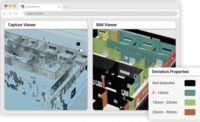ENR 2020 Top 25 Newsmakers
Eric Law: Mixed Robots, Reality Capture and Data Analysis for Better Work Progress Tracking

Law combined a Boston Dynamics robot with several other technologies in an effort to automate documentation of work put-in-place.
Photo Courtesy of Swinerton
New technologies are offered up to the construction industry every day, but actually stitching them together into a usable workflow is the real challenge. Looking to develop new processes for documenting work progress on site, Swinerton’s senior director, technology and innovation Eric Law took a pitch from Avvir, an image and scan data analysis firm, and paired it with the automated site roaming capabilities of Boston Dynamics’ robotic dog, Spot. The result was an ambitious pilot project that theoretically could reduce payment times to subcontractors from weeks to days.
As Spot walks a jobsite, it uses a scanner payload to capture point cloud and 360° camera data of its surroundings, day after day. That data is then ingested by image capture firm Kaarta and handed off to Avvir for processing. Avvir’s algorithms can determine the amount of work performed and installed between each upload, with results back in only a few days. Law sees this as a replacement for the regular inspections done by site supervisors, allowing for faster payments to be made to building trades and other subcontractors.
Raffi Holzer, CEO of Avvir, had come to Law to pitch him on using their technology to measure work progress against a project’s BIM. But when Law challenged him to make it work with the Spot robot in a single workflow, Holzer knew this could be something special. “I don’t think technology in this industry can change it by itself,” says Holzer. “We have to find the change agents who are there to take advantage of [technology.]”
The pilot project was a medical office building in Redwood City, Calif., where Law and his team were able to use a combination of the robot, LiDAR scans and BIM-based data analysis to track drywall installations in the building interiors. In a case study they put together afterward, Law and the team concluded that there is a real business case to be made for automating this kind of work-progress tracking. The eventual goal of the workflow is to get the time it takes to pay subcontractors down from a typical 90 days to under a week.
Law oversaw the pilot and assembled the team of tech firms that contributed, using some of the skills he developed in his time at Bentley Systems, where he was head of project management software after it acquired his construction collaboration software firm, EADOC.
In addition to fielding inquiries about this particular pilot effort from colleagues and industry competitors alike, he says he is well along on running trials of five or six other experimental workflows over the course of the year. “We try to do this with all solutions we develop,” he says. “Typically, we get it to the point where we validate the solution, then we share it with our peers.”
Law is also adamant about getting the most out of a pricey Boston Dynamics Spot robot dog. He says many in the industry so far have only used it as a fancy tripod for taking jobsite photos and haven’t yet begun to tap the full potential of the little autonomous quadruped.
“We’re still waiting for some of the technology to mature, and we’re working with Boston Dynamics to help build out that autonomous capability,” he says. “But I still believe a quadruped robot is the best platform for capturing data indoors on jobsites.”




